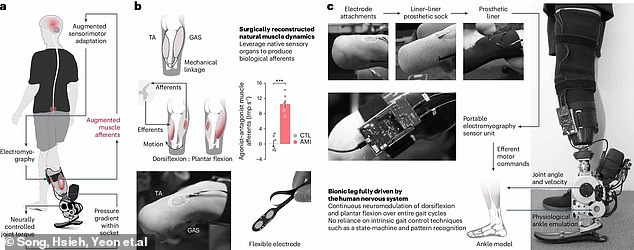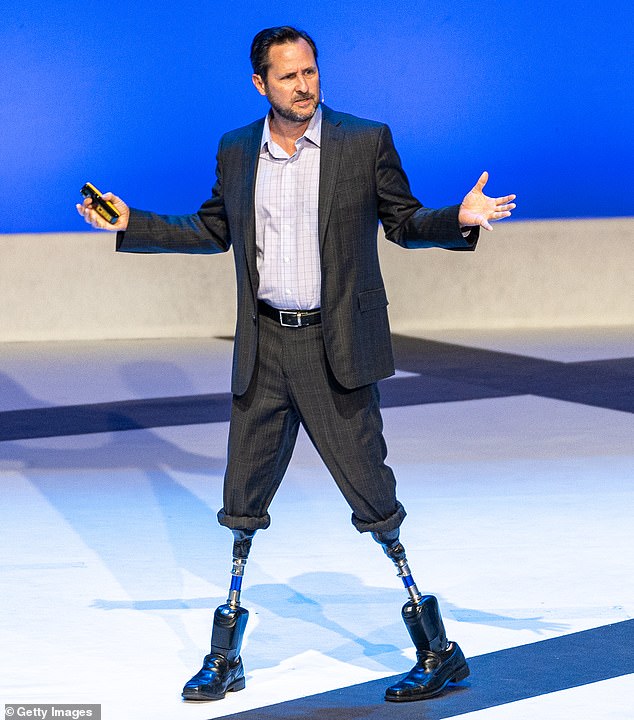Incredible bionic leg is controlled by human thoughts – and makes it easier for amputees to climb up stairs
Scientists have developed a prosthetic leg controlled by the human brain, allowing amputees to climb up and down stairs more easily.
The groundbreaking new device allows patients to control their prosthesis directly with their thoughts.
The device records signals from surgically preserved muscles, which are precisely monitored and converted into controls for a robotic ankle.
A study of 14 amputees found that the leg created a more natural motion, improved stability on uneven terrain and increased speed by 41%.
And the researchers now hope that a commercial version of the bone will no longer be available within five years.
As this diagram shows, the bionic legs work by taking signals from the remaining muscles and converting them into commands for an electronic ankle
Study author Professor Hugh Herr said: ‘This is the first prosthetics study in history to demonstrate a prosthetic leg under full neural modulation, producing a biomimetic walking motion.
In their study, published in Nature Medicine, the researchers claim that their new technique allows patients to receive ‘proprioceptive’ feedback from the limb.
During the trials, the researchers found that patients could walk as fast as someone without an amputation and develop natural movements, such as lifting their toes when climbing stairs.
This improved level of control is possible thanks to the new surgical amputation technique the researchers tested.
In the traditional applications below, the muscles that normally control the foot are wrapped around the severed limb to create a soft padding.
However, this process breaks the normal connection between the ‘antagonistic’ pairs of pushing and pulling muscles in the leg.

Researchers at MIT have developed a new type of bionic leg that allows patients to control the limb directly with their thoughts
Instead, the device requires patients to undergo a new form of below-the-knee amputation called an agonist-antagonist myoneural interface (AMI).
The ends of the muscles are connected to each other so that they can still communicate with each other within the stump.
In previous research, Professor Herr and his colleagues discovered that signals from these remaining muscles could be used to replicate the natural movements of the foot.
By recording the signals, the robotic ankle knows how far and how hard the foot should be bent and rotated, allowing the patient to control the limb naturally.
This procedure can be performed during the initial amputation of the leg or during a later revision procedure. It can also be performed on the arms.
So far, only 60 people have undergone the procedure, but researchers hope it will pave the way for more natural bionic limbs.

The leg works by picking up signals in surgically preserved muscles that are converted into instructions for the electronic ankle
Lead author Hyungeun Song, a postdoctoral researcher at MIT, says, “The AMI neuroprosthetic interface allowed us to amplify neural signaling while preserving as much of it as possible.
‘This allowed a person’s neural ability to be restored to continuously and instantly control their entire gait, regardless of walking speed, when climbing stairs, ramps and even obstacles.’
Importantly, the study also found that patients were more likely to report feeling like their new prosthesis was part of their body.
The best prosthetics can help amputees regain their natural gait through robotic sensors and pre-determined gait algorithms.
However, these prostheses still do not allow the patient to control their new robotic limb as if it were part of their original body.

Study author Professor Hugh Herr (pictured) says the technique gives patients the feeling that the limb is part of their own body

Professor Hare (pictured) hopes to achieve the goal of ‘rebuilding human bodies’, rather than having patients control increasingly sophisticated robotics
Professor Herr says: ‘No one has yet been able to demonstrate such a level of brain control that produces a natural gait, where the human nervous system controls the movement rather than a robotic control algorithm.
Professor Hare, who is a double amputee himself, says the problem with robotic prostheses is that the patient does not feel the new limb as part of their body.
Even though the patients received only 20 percent of the sensory feedback that someone without an amputation would feel, they still developed natural walking habits, as if they were using a biological limb.
By giving patients direct control over their limbs, Professor Hare hopes to achieve his goal of ‘rebuilding the human body’.
He says: ‘Our approach is to connect the human brain with electromechanics in a comprehensive way.’
